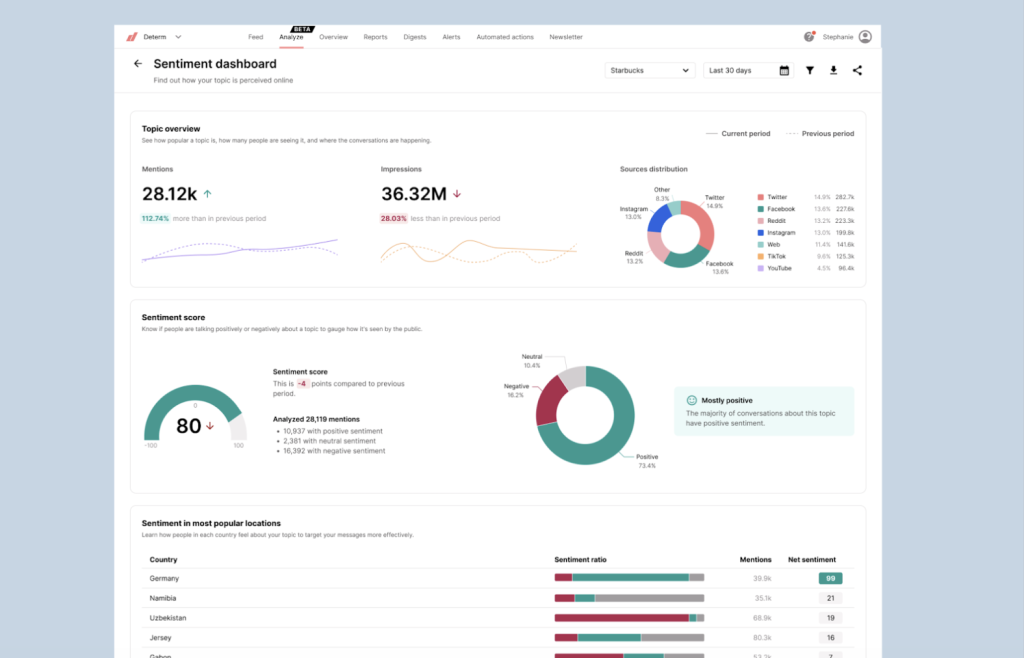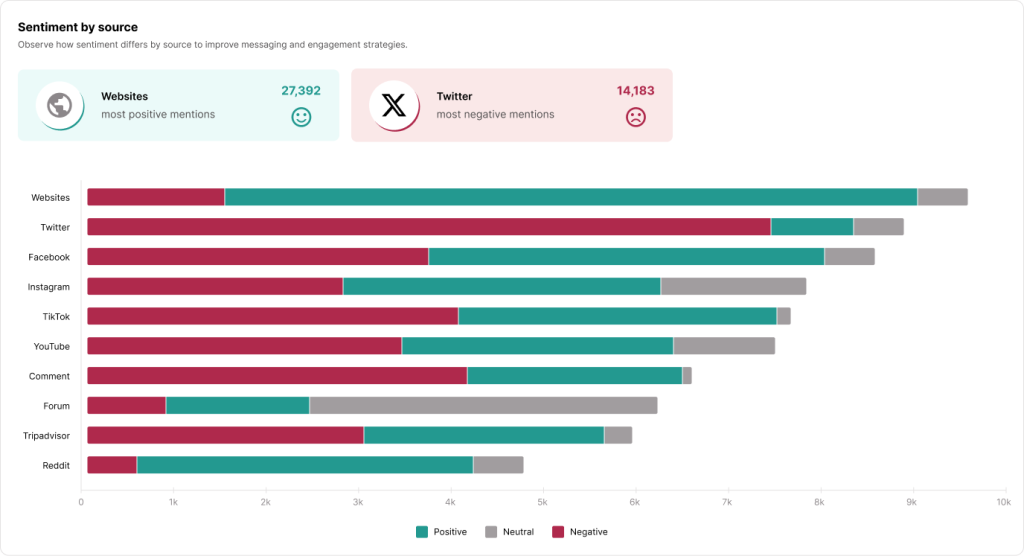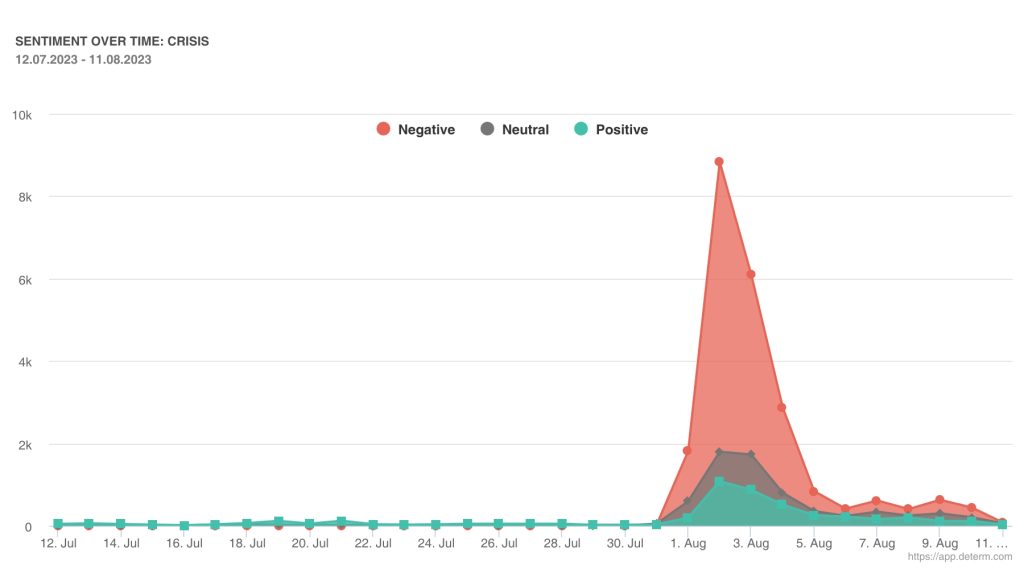There is one thing remains constant in the business world: emotions drive decisions.
But how can you know what kind of an emotional effect does your brand have?
Meet sentiment analysis, a game-changing tool that unveils the true essence of customer feelings. In the age of social media, customer reviews, and digital chatter, understanding the pulse of your brand has never been more vital.
💡 Read Sentiment Analysis 101: Everything You Need to Know
This transformative technology dives deep into the realm of emotions, empowering you to fine-tune your brand strategy like never before.
What is Sentiment Analysis?
Sentiment analysis, also known as opinion mining, is like having a digital empath that dives into written text to figure out the feelings and opinions behind it. Imagine it as a tech-savvy friend who goes through loads of data to figure out if the vibes in the text are upbeat, downbeat, or just chill. This sophisticated process combines the realms of natural language processing (NLP) and machine learning to understand the emotional pulse of the text.

The Power of Sentiment Analysis in Brand Building
Sentiment analysis is more than just a buzzword. It’s a game-changing tool that holds the potential to revolutionize brand building for marketing professionals. Let’s explore the numerous benefits it brings to the table.
Competitive edge through differentiation
In the crowded marketplace, setting your brand apart is crucial. Sentiment analysis not only helps you understand your own brand’s sentiment but also provides insights into your competitors. This knowledge enables you to identify gaps in the market, refine your brand messaging, and offer unique value propositions that resonate deeply with your target audience.
Tailored content strategy
Crafting compelling content is a cornerstone of effective brand building. Sentiment analysis guides your content strategy by revealing the emotions and topics that engage your audience the most. This data-driven approach ensures that your content resonates on a personal level, fostering a stronger brand-consumer bond.
Read 7 Tips for Facebook Sentiment Analysis for Improved Marketing Tactics

Product development aligned with demand
Launching products without understanding customer sentiment is like shooting in the dark. Sentiment analysis helps you align product development with actual market demand. By identifying prevalent positive sentiments and areas of improvement, you can create products that genuinely satisfy your customers’ needs and aspirations.
Real-time pulse check
Sentiment analysis unveils genuine customer sentiments, providing deep insights into their likes, dislikes, and pain points. You can gauge customer sentiments in real-time, keeping a finger on the pulse of your brand’s perception. Identifying shifting sentiments promptly allows you to adapt swiftly to changing customer preferences.
Evolving with evolving sentiments
Sentiments are not static, they evolve over time and with changing trends. Sentiment analysis allows you to stay attuned to these shifts, enabling proactive adjustments to your brand strategy. What’s more, this adaptability ensures your brand remains relevant and appealing in the ever-changing landscape of consumer preferences.
Read Sentiment Analysis Challenges: Solutions and Approaches
How to Use Sentiment Analysis in Brand Building
By tapping into the full potential of sentiment analysis, you can elevate your brand’s perception and develop deeper connections with your audience. Let’s explore the best practices on how to use sentiment analysis in brand building that can make a significant impact on your journey:
Listen to your audience
Utilize sentiment analysis to monitor social media platforms and customer feedback:
Social media has become the beating heart of customer conversations, making it a goldmine of valuable insights. By leveraging sentiment analysis tools, you can actively track and analyze these conversations, including customer reviews and feedback. To ensure the security of these interactions, it’s essential to have an SSL certificate installed on your website, encrypting the sensitive information shared by your audience.
Furthermore, companies can also monitor and analyze customer conversations on social media platforms like Twitter, Instagram or Reddit. This real-time monitoring allows you to gain immediate insights into how your audience perceives your brand, products, and services.

Identify sentiment trends and gauge customer reactions to your brand:
Sentiment analysis goes beyond individual data points. It empowers you to identify sentiment trends over time. By spotting shifts in customer perceptions, you can gauge the effectiveness of your marketing campaigns, product launches, and brand events. Armed with this knowledge, you can adapt your strategies and offerings to meet the ever-changing expectations of your audience.
Identify brand advocates
Use sentiment analysis to spot loyal brand advocates and respond to them:
Brand advocates are the champions of your brand, and sentiment analysis can help you find them. To identify these advocates, focus on tracking individuals who actively engage with your content, express their experiences through user-generated content, and consistently portray a favorable sentiment. In addition, initiating personalized interactions, such as expressing gratitude or offering exclusive perks, can deepen these connections and inspire advocates to amplify their endorsements. Finally, this symbiotic relationship not only nurtures loyalty but also amplifies your brand’s reach organically, as authentic advocates become compelling storytellers in your brand’s journey.
Read Top 5 Examples of Sentiment Analysis
Address concerns raised by critics to minimise potential crises:
Every brand faces negative sentiments from time to time, but it’s crucial to address them proactively. Sentiment analysis helps you identify detractors’ concerns in real-time, allowing you to respond with empathy and solutions. Promptly addressing negative sentiments showcases your brand’s commitment to exceptional customer service, turning detractors into potential advocates and safeguarding your brand’s reputation.

Enhance communication strategies
Analyze sentiment to refine brand messaging and make it more impactful:
Think of sentiment analysis as your partner in perfecting brand communication. It’s like having a backstage pass to your audience’s emotions. For instance, let’s say an e-commerce company launches a new fashion line. By analyzing sentiment trends, you can uncover whether your messaging sparks excitement, perhaps due to trendy designs, or if there’s concern about pricing. With these insights, you can adapt your communication, whether it’s emphasizing affordability or highlighting exclusivity to ensure your brand resonates emotionally and connects authentically with your audience.
Read Customer Sentiment – Why You Should Track It
Personalize content based on emotional insights to resonate with target audiences:
Customers crave personalized experiences that speak directly to their needs and aspirations. As of statistics, 70% of customers feel frustrated when they do not receive a personalized experience. Sentiment analysis allows you to segment your audience based on emotional insights, enabling you to deliver tailored content that addresses specific emotions and preferences. This personalized approach creates more authentic and meaningful connections with your audience, fostering deeper engagement and loyalty.
Analyze competitor sentiment
Benchmark your brand against competitors:
Understanding your competitors is essential for staying ahead in the competitive landscape. Sentiment analysis enables you to analyze and compare competitor sentiment, gaining valuable insights into their emotional strengths, weaknesses, and overall brand perception. This benchmarking provides you with a deeper understanding of your brand’s competitive position and helps identify opportunities for improvement.
Identify gaps and opportunities to gain a competitive advantage:
By comparing competitor sentiments with your own, you can uncover areas where you have a competitive advantage and where you can improve. Sentiment analysis allows you to find unmet customer needs and emotional pain points in your industry, providing a roadmap for product innovation and differentiation. By addressing gaps and leveraging opportunities, you can position your brand more effectively and attract new customers.

Enhance influencer marketing
Identify suitable influencers to endorse your brand:
Influencers wield significant influence over consumer perceptions and decisions. Sentiment analysis helps you identify influencers whose sentiments align with your brand’s values and resonate with your target audience. Let’s say your brand is all about health and wellness – finding an influencer who genuinely radiates these sentiments adds a whole new level of authenticity.
Partnering with such influencers sparks a real connection that resonates with their followers. It’s not just a collaboration. In the end it’s a partnership that sparks genuine sentiment, making your brand’s message ring true and your reach grow organically.
Measure the impact of influencer campaigns on brand sentiment:
Influencer marketing is an investment and understanding impact isn’t just insightful; it’s a cornerstone of informed decision-making. By embracing sentiment analysis, you’re unearthing the emotional footprints etched by influencer collaborations while honing your brand’s tonal symphony.
Therefore, employ advanced sentiment analysis tools to extract sentiment trends from an array of sources such as mentions, reviews, and engagements across the life cycle of influencer campaigns. This real-time assessment empowers you to optimize your influencer strategies, fostering sentiment-aligned collaborations that resonate with your audience, generate authentic enthusiasm, and ultimately elevate your brand’s standing.
Improve customer feedback and product innovation
Customer feedback is a treasure trove of insights, but extracting meaningful data can be challenging. Sentiment analysis transforms this unstructured data into actionable information. Employ sentiment analysis to categorize sentiments to positive, negative, or neutral to provide an eagle-eye perspective on what delights customers and where improvements beckon. To dive deeper, use diverse feedback channels such as online reviews, social media, and even direct surveys to gather a comprehensive spectrum of sentiments. By analyzing customer sentiments in reviews and feedback, you gain a clear understanding of their pain points, preferences, and expectations. This emotional insight provides valuable guidance for making data-driven decisions that drive product improvements and innovation.
Read Sentiment Tracking: How to Get Inside Your Customers’ Minds?
Measure campaign success
The success of marketing campaigns is no longer measured solely by clicks and impressions. Sentiment analysis offers a more comprehensive view, allowing you to evaluate the emotional resonance of your campaigns. By understanding how customers perceive and feel about your marketing efforts, you can gauge their impact on brand sentiment and adjust your strategies accordingly.
Therefore, monitor sentiment changes during and after the campaign. If you notice a surge in positive sentiments post-launch, you’ve struck an emotional chord. Next, if there’s confusion about its functionality, consider addressing it promptly. Finally, the beauty of sentiment analysis is that it guides your strategies beyond surface metrics, helping you craft narratives that resonate emotionally and drive tangible results, fostering a connection that extends far beyond the campaign’s end.
Conclusion
Sentiment analysis unravels the true emotions surrounding your brand, empowering you to craft a winning strategy. When you take the time to really listen and jump into conversations for real, you’re basically laying down the groundwork for creating these awesome personal connections. And let’s be real, who doesn’t love feeling like a brand gets them, right?
So, with sentiment analysis on your side, you’re not just telling a story – you’re painting a whole masterpiece of feelings. And that’s how you strut confidently into the future of brand building, where those heartfelt bonds rule the kingdom.
Zuzana Hudecova is a marketing specialist for CloudTalk, helping to create compelling messaging in support of the next generation of cloud communication and call center softwares.


